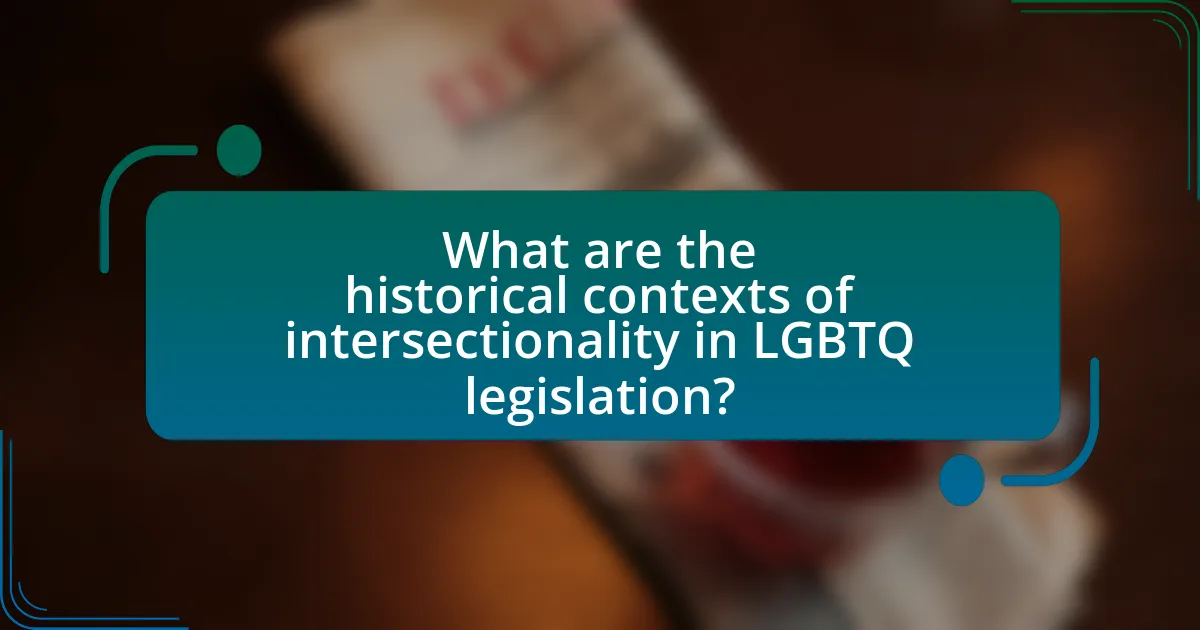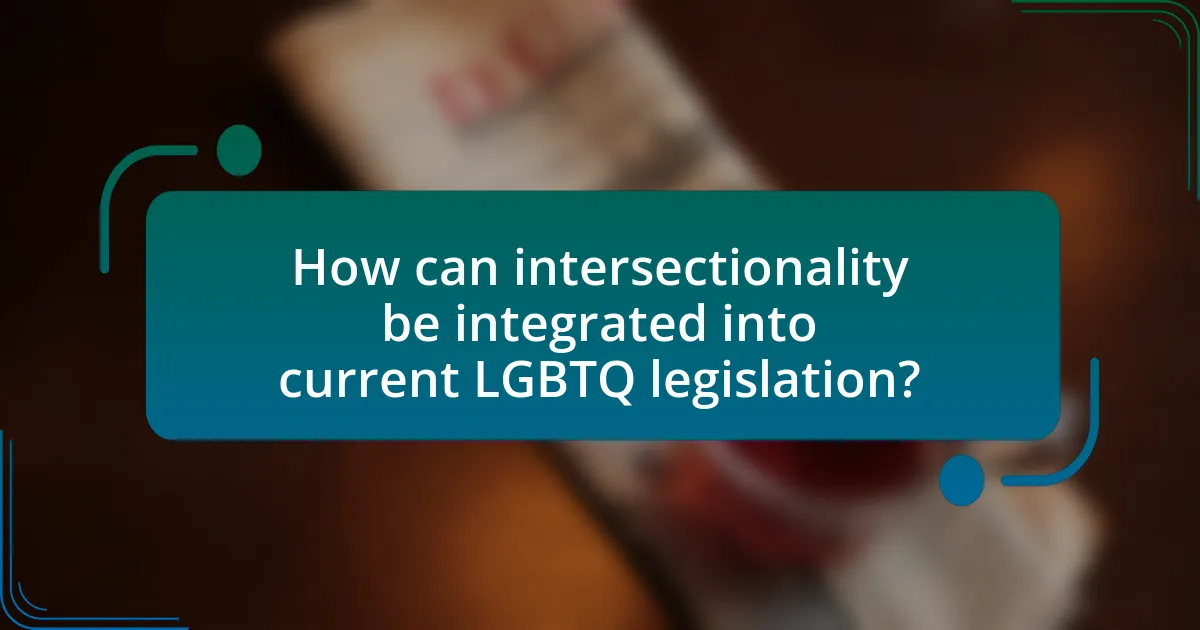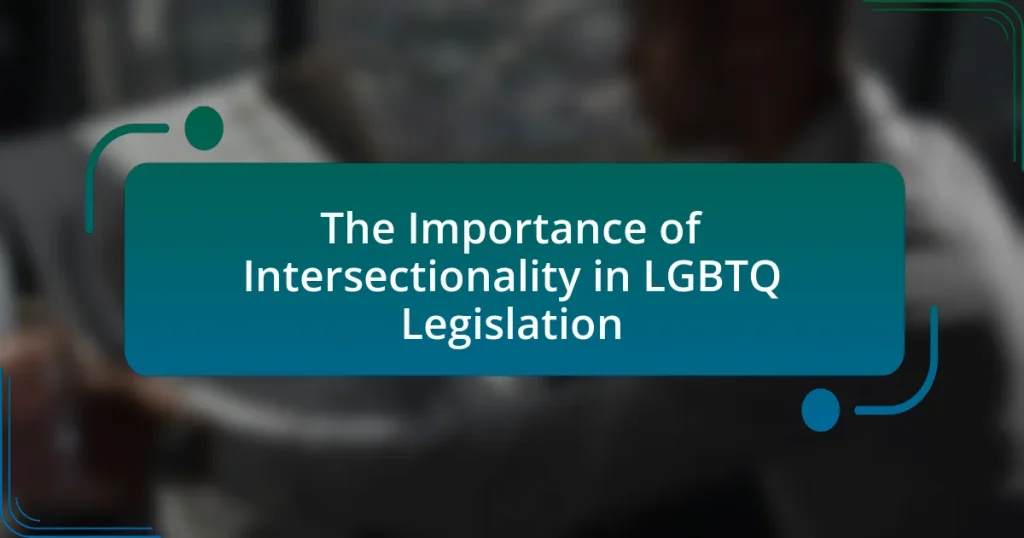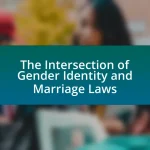The article focuses on the significance of intersectionality in LGBTQ legislation, emphasizing how overlapping identities such as race, gender, and socioeconomic status impact individuals’ access to rights and protections. It discusses the unique challenges faced by marginalized groups within the LGBTQ community, particularly highlighting the experiences of LGBTQ individuals of color and transgender individuals. The article outlines the importance of inclusive policy-making that addresses these intersecting identities, the historical context of intersectionality in LGBTQ rights movements, and the potential consequences of neglecting intersectional approaches in legislation. Additionally, it provides strategies for lawmakers and advocates to incorporate intersectionality into current and future LGBTQ legislation, ensuring equitable protections for all individuals.

What is the significance of intersectionality in LGBTQ legislation?
Intersectionality is significant in LGBTQ legislation because it recognizes that individuals experience multiple, overlapping identities that can affect their access to rights and protections. This framework highlights how factors such as race, gender, socioeconomic status, and disability intersect with sexual orientation and gender identity, leading to unique challenges for marginalized groups within the LGBTQ community. For instance, Black transgender individuals face higher rates of violence and discrimination compared to their white counterparts, underscoring the need for legislation that addresses these specific vulnerabilities. By incorporating intersectionality, lawmakers can create more inclusive policies that effectively address the diverse needs of all individuals within the LGBTQ spectrum, ensuring equitable access to rights and protections.
How does intersectionality influence the experiences of LGBTQ individuals?
Intersectionality significantly influences the experiences of LGBTQ individuals by highlighting how overlapping social identities, such as race, gender, and socioeconomic status, create unique challenges and discrimination. For instance, LGBTQ individuals of color often face compounded biases that differ from those experienced by white LGBTQ individuals, leading to higher rates of violence and discrimination. According to a 2020 report by the Human Rights Campaign, Black transgender individuals are disproportionately affected by violence, with 44% of reported murders of transgender individuals in the U.S. being Black. This illustrates that intersectionality is crucial for understanding the diverse experiences within the LGBTQ community and informs the need for tailored legislative protections that address these intersecting identities.
What are the key components of intersectionality in this context?
The key components of intersectionality in the context of LGBTQ legislation include the recognition of overlapping social identities, the impact of systemic discrimination, and the necessity for inclusive policy-making. Overlapping social identities, such as race, gender, and sexual orientation, create unique experiences of oppression and privilege that must be acknowledged in legislative frameworks. Systemic discrimination affects marginalized groups differently, necessitating an understanding of how various forms of inequality intersect. Inclusive policy-making ensures that the needs of all individuals, particularly those at the intersections of multiple marginalized identities, are addressed, promoting equity and justice within LGBTQ legislation.
How do different identities intersect to affect LGBTQ rights?
Different identities intersect to affect LGBTQ rights by creating unique experiences of discrimination and privilege that influence advocacy and policy outcomes. For instance, individuals who identify as LGBTQ and belong to racial or ethnic minorities often face compounded challenges, such as systemic racism and homophobia, which can hinder their access to resources and legal protections. Research from the Williams Institute indicates that LGBTQ people of color experience higher rates of violence and discrimination compared to their white counterparts, highlighting the need for intersectional approaches in legislation. This intersectionality is crucial for understanding the diverse needs within the LGBTQ community and ensuring that laws address the specific barriers faced by various subgroups, ultimately leading to more equitable rights and protections.
Why is intersectionality crucial for effective LGBTQ advocacy?
Intersectionality is crucial for effective LGBTQ advocacy because it recognizes that individuals experience multiple, overlapping identities that can compound discrimination and marginalization. This framework allows advocates to address the unique challenges faced by LGBTQ individuals who also belong to other marginalized groups, such as people of color, those with disabilities, or individuals from low-income backgrounds. Research by the American Psychological Association highlights that intersectional approaches lead to more comprehensive policies and support systems, ultimately resulting in better outcomes for diverse LGBTQ populations. By understanding and addressing these intersecting identities, advocacy efforts can be more inclusive and effective in promoting equality and justice.
What are the potential consequences of ignoring intersectionality in legislation?
Ignoring intersectionality in legislation can lead to systemic discrimination and exacerbate inequalities among marginalized groups. When laws do not consider the overlapping identities of individuals—such as race, gender, sexual orientation, and socioeconomic status—specific needs and challenges faced by these groups may be overlooked. For instance, research by the American Psychological Association indicates that LGBTQ individuals of color experience higher rates of discrimination and violence compared to their white counterparts, highlighting the necessity of intersectional approaches in policy-making. Consequently, legislation that fails to address these complexities can perpetuate social injustices, limit access to resources, and hinder the overall effectiveness of legal protections for vulnerable populations.
How can intersectional approaches enhance advocacy efforts?
Intersectional approaches enhance advocacy efforts by addressing the diverse and overlapping identities within marginalized communities, leading to more inclusive and effective strategies. By recognizing how factors such as race, gender, sexual orientation, and socioeconomic status intersect, advocates can tailor their messages and actions to resonate with a broader audience. Research indicates that intersectional advocacy can increase engagement and support, as seen in campaigns that successfully mobilized diverse coalitions to address issues like discrimination and healthcare access. For example, the 2017 Women’s March incorporated intersectionality, amplifying voices from various backgrounds and resulting in a significant increase in public awareness and policy discussions surrounding LGBTQ rights.

What are the historical contexts of intersectionality in LGBTQ legislation?
The historical contexts of intersectionality in LGBTQ legislation highlight the interconnectedness of various social identities and their impact on legal rights. Intersectionality emerged as a framework in the late 20th century, primarily through the work of scholars like Kimberlé Crenshaw, who emphasized how overlapping identities—such as race, gender, and sexual orientation—affect individuals’ experiences of discrimination and privilege. In LGBTQ legislation, this concept became crucial during the fight for rights in the 1980s and 1990s, particularly in response to the AIDS crisis, which disproportionately affected marginalized communities, including people of color and low-income individuals. Legislative efforts, such as the Employment Non-Discrimination Act (ENDA) and the repeal of “Don’t Ask, Don’t Tell,” reflected the need to address these intersecting identities, as advocates recognized that a one-size-fits-all approach to LGBTQ rights often overlooked the unique challenges faced by individuals at these intersections. This historical context underscores the importance of inclusive policies that consider the diverse experiences within the LGBTQ community.
How has intersectionality evolved within LGBTQ rights movements?
Intersectionality has evolved within LGBTQ rights movements by increasingly recognizing and addressing the diverse experiences and challenges faced by individuals at the intersections of multiple identities, such as race, gender, and socioeconomic status. Initially, LGBTQ movements primarily focused on sexual orientation and gender identity, often sidelining the unique struggles of marginalized groups within the community. Over time, activists and scholars, such as Kimberlé Crenshaw, who coined the term “intersectionality,” have highlighted the necessity of an inclusive approach that considers how various forms of discrimination overlap. This shift has led to more comprehensive advocacy efforts, such as the incorporation of issues like racial justice, economic inequality, and disability rights into LGBTQ activism, ultimately fostering a more holistic understanding of equality and justice within the movement.
What key events have shaped the understanding of intersectionality in this field?
Key events that have shaped the understanding of intersectionality in LGBTQ legislation include the Combahee River Collective Statement in 1977, which articulated the need to consider multiple identities, and the 1990s emergence of the term “intersectionality” by Kimberlé Crenshaw, emphasizing how overlapping social identities impact experiences of discrimination. Additionally, the 2015 Supreme Court case Obergefell v. Hodges, which legalized same-sex marriage, highlighted the necessity of recognizing diverse identities within LGBTQ rights. These events collectively underscore the importance of intersectionality in advocating for comprehensive and inclusive legislation that addresses the unique challenges faced by individuals at the intersections of various identities.
How have different social movements influenced LGBTQ legislation?
Different social movements have significantly influenced LGBTQ legislation by advocating for equal rights and social justice, leading to legal reforms. For instance, the Civil Rights Movement of the 1960s laid the groundwork for LGBTQ activism by promoting the idea of equality under the law, which inspired LGBTQ leaders to push for similar rights. The Stonewall Riots in 1969 marked a pivotal moment, galvanizing the LGBTQ community and leading to the formation of organizations that lobbied for legislative changes, such as the decriminalization of homosexuality and the recognition of same-sex relationships. Additionally, the feminist movement has intersected with LGBTQ advocacy, emphasizing the importance of gender equality and challenging traditional norms, which has resulted in broader support for LGBTQ rights in legislation. The impact of these movements is evident in landmark legal decisions, such as the U.S. Supreme Court’s ruling in Obergefell v. Hodges (2015), which legalized same-sex marriage nationwide, showcasing the direct correlation between social movements and legislative progress for LGBTQ individuals.
What role do marginalized identities play in shaping LGBTQ legislation?
Marginalized identities significantly influence the development of LGBTQ legislation by highlighting the diverse experiences and needs within the community. These identities, including race, gender, socioeconomic status, and disability, bring attention to the unique challenges faced by individuals at the intersections of multiple forms of discrimination. For instance, research by the Movement Advancement Project indicates that LGBTQ people of color experience higher rates of violence and discrimination compared to their white counterparts, which necessitates tailored legislative protections. Furthermore, the inclusion of voices from marginalized groups in advocacy efforts has led to more comprehensive laws, such as the Equality Act, which aims to address discrimination based on sexual orientation and gender identity while also considering intersecting factors. This intersectional approach ensures that legislation is not only inclusive but also effective in addressing the specific needs of all members of the LGBTQ community.
How do race, gender, and socioeconomic status intersect with sexual orientation?
Race, gender, and socioeconomic status significantly intersect with sexual orientation, influencing individuals’ experiences and access to resources. For instance, LGBTQ individuals of color often face compounded discrimination due to both their racial and sexual identities, leading to higher rates of violence and mental health issues compared to their white counterparts. Research by the Williams Institute indicates that LGBTQ people of color experience higher poverty rates, which can limit access to healthcare and legal protections. Additionally, gender identity plays a crucial role; transgender individuals, particularly those from marginalized racial backgrounds, encounter unique challenges, including higher rates of unemployment and homelessness. These intersections highlight the necessity for inclusive policies that address the specific needs of diverse LGBTQ populations, as evidenced by the disparities in health outcomes and economic stability documented in studies such as the National LGBTQ Task Force’s “Injustice at Every Turn.”
What specific challenges do marginalized LGBTQ individuals face in legislation?
Marginalized LGBTQ individuals face significant challenges in legislation, primarily due to systemic discrimination and lack of representation. These individuals often encounter legal barriers that fail to protect them from discrimination based on sexual orientation, gender identity, and intersecting identities such as race and socioeconomic status. For instance, the Human Rights Campaign reported that many states lack comprehensive non-discrimination laws, leaving LGBTQ individuals vulnerable to job loss, housing instability, and denial of services. Additionally, marginalized groups within the LGBTQ community, such as transgender people of color, experience higher rates of violence and discrimination, which are often inadequately addressed by existing laws. This intersectional discrimination highlights the urgent need for inclusive legislation that considers the diverse experiences of all LGBTQ individuals.

How can intersectionality be integrated into current LGBTQ legislation?
Intersectionality can be integrated into current LGBTQ legislation by explicitly addressing the diverse identities and experiences within the LGBTQ community, such as race, gender, socioeconomic status, and disability. This integration can be achieved through comprehensive policy frameworks that include provisions for anti-discrimination protections that consider multiple intersecting identities. For instance, the Equality Act in the United States aims to prohibit discrimination based on sexual orientation and gender identity while also recognizing the importance of intersecting factors like race and disability, thereby ensuring that marginalized groups within the LGBTQ community receive equitable protections. Research from the Movement Advancement Project highlights that inclusive legislation leads to better outcomes for individuals facing multiple forms of discrimination, reinforcing the necessity of intersectionality in legal protections.
What strategies can lawmakers use to incorporate intersectionality?
Lawmakers can incorporate intersectionality by conducting comprehensive impact assessments that consider how various identities intersect and affect individuals’ experiences. These assessments should analyze the implications of proposed legislation on diverse groups, including LGBTQ individuals, people of color, and those with disabilities. For instance, the 2019 report by the Movement Advancement Project highlights that intersectional approaches in policy-making can lead to more equitable outcomes by addressing the unique challenges faced by marginalized communities. Additionally, lawmakers can engage with grassroots organizations that represent intersectional identities to gather insights and ensure that policies reflect the needs of those affected. This strategy is supported by research from the Center for American Progress, which emphasizes the importance of community involvement in creating inclusive legislation.
How can community input shape intersectional legislation?
Community input can shape intersectional legislation by ensuring that diverse perspectives and experiences are represented in the policymaking process. Engaging marginalized groups, such as LGBTQ individuals of various races, ethnicities, and socioeconomic backgrounds, allows legislators to understand the unique challenges these communities face. For instance, the 2019 Equality Act in the United States was influenced by extensive advocacy from LGBTQ organizations that highlighted the need for protections against discrimination based on sexual orientation and gender identity, as well as intersecting factors like race and disability. This input led to more comprehensive legislation that addresses the multifaceted nature of discrimination, demonstrating that community voices are essential for creating effective and inclusive laws.
What best practices exist for drafting inclusive policies?
Best practices for drafting inclusive policies include engaging diverse stakeholders, conducting thorough research on the needs of marginalized groups, and ensuring language is clear and accessible. Engaging stakeholders, such as LGBTQ community members and advocacy organizations, fosters a comprehensive understanding of the issues faced by these groups. Research, including data on discrimination and barriers, informs policy decisions and highlights specific needs. Clear and accessible language ensures that policies are understandable to all, promoting transparency and inclusivity. These practices are supported by studies indicating that inclusive policies lead to better outcomes for marginalized communities, as seen in the 2020 report by the Human Rights Campaign, which emphasizes the importance of stakeholder engagement in policy development.
What are the implications of intersectionality for future LGBTQ legislation?
Intersectionality will significantly shape future LGBTQ legislation by ensuring that laws address the diverse experiences and needs of individuals within the community. This approach recognizes that factors such as race, gender identity, socioeconomic status, and disability intersect to create unique challenges for LGBTQ individuals. For instance, research from the Movement Advancement Project highlights that LGBTQ people of color face higher rates of discrimination and violence compared to their white counterparts, indicating that legislation must be tailored to protect these vulnerable groups specifically. By incorporating intersectional perspectives, future laws can promote equity and inclusivity, ultimately leading to more effective protections and support for all members of the LGBTQ community.
How can intersectionality inform the development of new laws?
Intersectionality can inform the development of new laws by ensuring that legislation addresses the diverse and overlapping identities of individuals, particularly in marginalized communities. This approach recognizes that individuals experience discrimination and privilege differently based on their race, gender, sexual orientation, and other social categories. For instance, the 2015 U.S. Supreme Court ruling in Obergefell v. Hodges, which legalized same-sex marriage, highlighted the need for laws that consider the unique challenges faced by LGBTQ individuals, especially those of color. By incorporating intersectional analysis, lawmakers can create more equitable policies that protect the rights of all individuals, acknowledging the complexities of their lived experiences.
What potential barriers exist to implementing intersectional approaches?
Potential barriers to implementing intersectional approaches include a lack of understanding and awareness of intersectionality among policymakers and stakeholders. This gap in knowledge can lead to oversimplified views of identity and oppression, which fail to address the complexities faced by individuals at the intersections of multiple marginalized identities. Additionally, institutional resistance to change, rooted in established norms and practices, can hinder the adoption of intersectional frameworks. Research indicates that organizations often prioritize single-axis approaches, which can marginalize the experiences of those who do not fit neatly into one category. Furthermore, limited resources and funding for intersectional initiatives can restrict the ability to develop and implement comprehensive strategies that address diverse needs within LGBTQ communities.
What practical steps can advocates take to promote intersectionality in LGBTQ legislation?
Advocates can promote intersectionality in LGBTQ legislation by actively engaging with diverse communities to understand their unique challenges and needs. This involves conducting inclusive outreach efforts that prioritize voices from marginalized groups within the LGBTQ community, such as people of color, transgender individuals, and those with disabilities. Research indicates that intersectional approaches lead to more comprehensive policy outcomes, as seen in the 2019 Equality Act, which aimed to address discrimination across multiple identities. By collaborating with intersectional organizations and utilizing data to highlight disparities, advocates can effectively push for legislation that reflects the complexities of identity and ensures equitable protections for all individuals.
How can grassroots movements effectively address intersectional issues?
Grassroots movements can effectively address intersectional issues by fostering inclusive coalitions that represent diverse identities and experiences. These movements prioritize collaboration among marginalized groups, ensuring that the unique challenges faced by individuals at the intersections of race, gender, sexuality, and class are recognized and addressed. For instance, the Black Lives Matter movement has successfully highlighted the intersection of racial and LGBTQ+ issues, advocating for policies that protect the rights of Black LGBTQ+ individuals. This approach is supported by research from the Movement Advancement Project, which indicates that intersectional advocacy leads to more comprehensive policy solutions that benefit a broader range of communities. By centering the voices of those most affected, grassroots movements can create targeted strategies that effectively tackle the complexities of intersectionality in social justice initiatives.
What resources are available for educating others about intersectionality in LGBTQ rights?
Educational resources for understanding intersectionality in LGBTQ rights include academic articles, online courses, and community workshops. Notable academic articles such as “Intersectionality and LGBTQ Rights” by Kimberlé Crenshaw provide foundational insights into how various social identities intersect and affect experiences of discrimination. Online platforms like Coursera and edX offer courses on intersectionality that cover its implications in LGBTQ contexts, often featuring contributions from experts in the field. Additionally, organizations like the Human Rights Campaign and GLAAD provide workshops and educational materials aimed at fostering awareness and understanding of intersectionality within LGBTQ advocacy. These resources collectively enhance knowledge and promote informed discussions about the complexities of identity and rights within the LGBTQ community.


